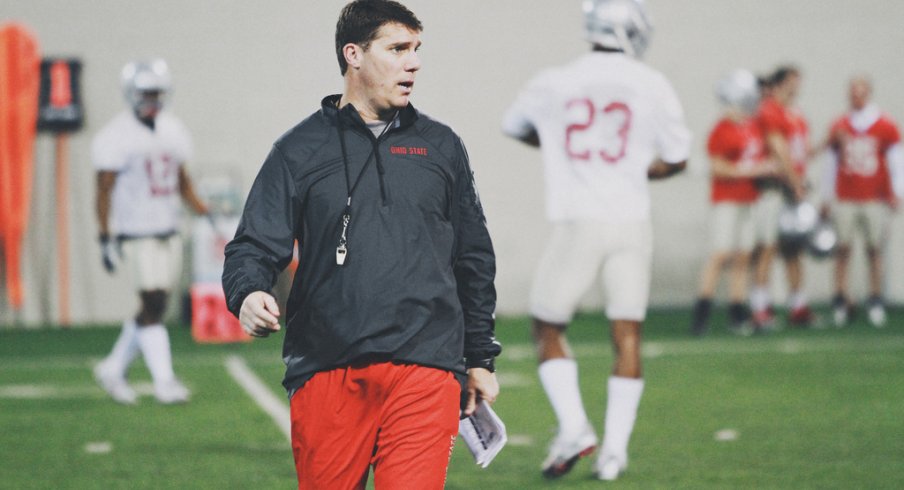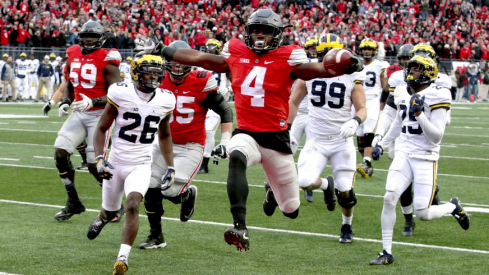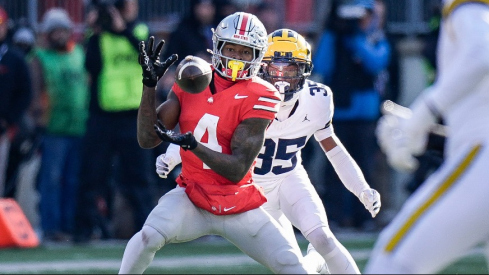We're thrilled to welcome Kyle Jones to the staff where he'll join Ross Fulton in Eleven Warriors' Pigskin Scheme, Philosophy and Analytics department. He's here to help make us smarter.
You can find Kyle on Twitter as @Jones. Also, we're at peak Kyle.
Much has been said for the past month about the hiring of Ohio State’s new Co-Defensive Coordinator, Chris Ash. The former leader of the Universities of Arkansas and Wisconsin defenses has been looked upon as the answer to many Buckeye fans’ prayers, bringing an aggressive, yet disciplined philosophy to a unit that ultimately became the Achilles heel in a failed bid for a National Championship.
While many fans may be expecting Ash to lead a unit that will stop the run, play stifling man-to-man pass defense, and pressure the quarterback on every play (which may one day be so), the reality is that Ash’s philosophies are not too different from what OSU has put on the field in the past.
Formations and Base Personnel
Like 95% of FBS coaches, and as OSU has run for decades, Ash prefers a base 4-3 defense. Luckily OSU has the personnel in place to immediately run his schemes, without having to re-invent the wheel.
The biggest difference between Ash’s defenses and those of Luke Fickell (and previously, Jim Heacock), are how his squads align to the ‘strength’ of the opponent’s formation.
As seen below, Ohio State has consistently aligned their defense in a field/boundary setup, meaning the better players on OSU’s defense (such as Bradley Roby and Ryan Shazier) lined up to the side of the field closest to the sideline:
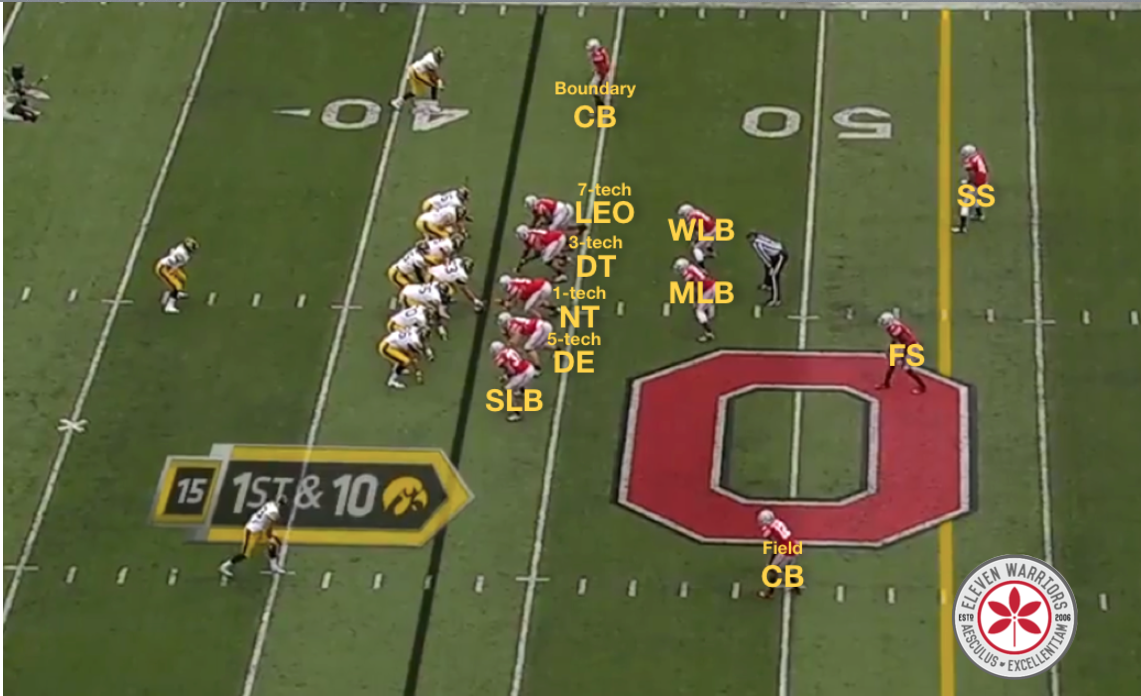
At Wisconsin and Arkansas, Ash aligned his teams to the side of the formation where the opponent has more players (such as a tight end or slot receiver), giving an advantage in the run game:
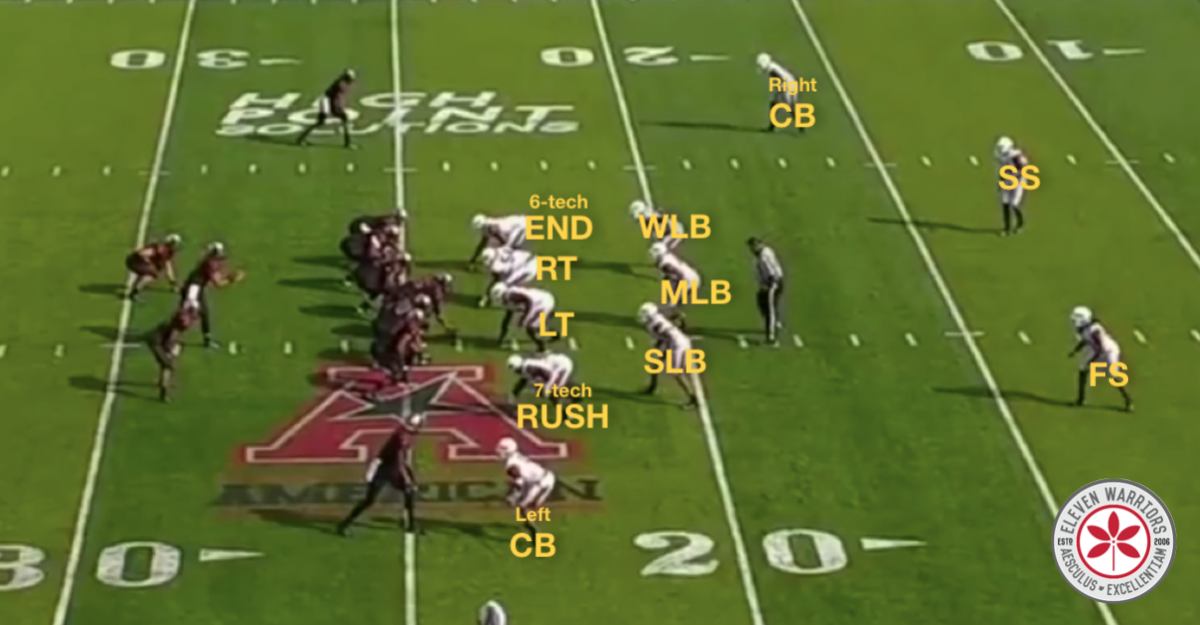
Defensive Line
Ash likes to align his Defensive Tackles as simply Right and Left, trading responsibilities depending on the situation. However, the alignment of his Defensive Ends is determined by the Tight End, as he will have one DE that ALWAYS lines up over the opposing Tight End (called an “END” in his defenses), and one that is always uncovered (called a RUSH), lined up outside the tackle.
The “End” position was manned at Wisconsin by Ash’s most prized pupil, JJ Watt, so the likely predecessor in Columbus will be Joey Bosa, who possesses a similar (although very un-refined in comparison) skill set and build to Watt. The responsibilities of the ‘Rush’ end are very similar to the “Leo” position that OSU has had in the past, and is currently manned by Noah Spence. Spence should benefit though, from never having to line up over an opposing tight end, where he would struggle and disappear at times last season. Once he is back from his 2-game suspension, he should be able to use his athleticism to track run down plays from behind, as well as only deal with a tackle and potentially a running back in pass rush situations, instead of being doubled by a tackle and tight end.
Linebackers
Ash likes to run the 4-3 Under alignment that is shown in the OSU example above, which brings the Strong-side Linebacker (SLB or SAM) up over the Tight End, effectively giving the defense 5 men on the line of scrimmage. But as the screen caps above show, he will also run a traditional 4-3 “stack” alignment, where all 3 Linebackers line up off the line of scrimmage, behind the 4 defensive linemen (as seen in the Arkansas example).
Josh Perry is the odds-on favorite to start at the SLB position, as he has in the past for the Buckeyes. Ash likes to have an athletic linebacker with long arms at that spot, which is perfect for Perry.
Much has been said about the ongoing battle between Senior, Curtis Grant, and the incoming Freshman, Raekwon McMillan, for the Middle Linebacker spot. Both bring size and athleticism to the position, however, of the 3 LB spots, the MLB doesn't have to be an all-world athlete in Ash's system, as they aren't often required to cover backs 1 on 1 in pass coverage.
The biggest change for OSU linebackers will be in the "stack" alignment, as the Weak-side Linebacker (WLB or WILL) will actually line up on the ‘strong’ side of the formation. The reason being that he is covered up by 2 defensive linemen in front of him, and should be free to roam around and make a play without worrying about opposing offensive linemen.
The WLB spot has been manned by Ryan Shazier for the past 3 seasons in Columbus, and his shoes won't be easy to fill. This position requires the most athleticism of the 3 LB spots, and is often relied upon to cover the most ground and make tackles as the other members of the front 7 are often occupying opposing blockers. This is a key position to watch throughout Spring practice, as Ash, Fickell, and the rest of the OSU defense will be relying on this spot to produce come the fall.
Defensive Backs
Much like the Defensive Tackles, Ash lines up his Cornerbacks as Right & Left, not aligning them to a particular strength. In passing situations, Ash removes the Strong-side Linebacker in favor of a 3rd Cornerback (or Nickelback), but isn’t as quick to make that move (especially on 1st and 2nd down) as Luke Fickell has been in the past. Against spread offenses, expect to see Ohio State line up with the 3rd Cornerback quite a bit though.
The biggest change for OSU will be at the safety spot, where Ash prefers to have 2 safeties on the field with similar skill sets, allowing them to interchange responsibilities, depending on what the opponent is showing. They will align to the strength of the opponent's formation though, unlike the corners.
Additionally, Safeties in Ash's system are the Quarterbacks of the defense. Due to their deep alignment and the ever-growing popularity of spread offenses, the Safeties usually have the best vantage point for setting the defensive formation and making adjustments at the line. This will certainly be worth watching during the Spring Game, as a group of underclassmen such as Vonn Bell and Tyvis Powell, will all be looking to stand out and gain playing time this fall. The players that are able to best adjust to commanding the defense from a mental and vocal standpoint will have a leg up on their competition heading into the fall.
The main takeaway for fans here though, is not to expect a whole lot to look different when it comes to OSU’s alignment on defense. The biggest differences between Ash and Fickell are fairly small items, and it may well be easier to keep the current personnel aligning as they have in the past, without adding one more thing to learn.
Philosophies
In his DVD, 'Aggressive 4-3 Defense: Setting Up The System', Ash describes many of his core tenets, using words such as “Hustle” and “Desire,” but also focusing on minimizing big plays, creating takeaways, and putting a priority on stopping the run.
This all sounds like the philosophies of any defensive minded football coach (I am yet to hear a defensive coach announce that his team will be "passive"), but one of the first items that gives Ash his identity was his focus not just on stopping the run, but HOW his teams will stop the run.
While many teams regularly align with one safety closer to the line of scrimmage, effectively acting like a 4th linebacker, Ash prefers to line up both safeties deep before the snap, with one of the Defensive Backs being responsible to come up to the line and support the run defense while the others maintain deep coverage of the wide receivers.
Which defensive back is responsible is entirely dependent on the play-call, and can change on every play. This is part of a larger desire to run multiple schemes out of a limited number of formations and alignments, in an attempt to simplify things for his players.
As you can see below in a clip from his Arkansas defense last year, both safeties appear in a 2-deep look before the snap:

But at the first hint of run, the Free Safety (circled) crashes down, as he was called on to be the 8th defender in the box (he ended up making the tackle on this play).
In certain games this year, Arkansas showed a quarter-quarter-half defense, bringing the CB closest to the sideline (or, boundary CB) into the box as the 8th defender. If this kind of strategy sounds familiar, it should, as Ohio State used this scheme with Bradley Roby playing the role of the 8th man (yellow circle), as a staple of the defense over the past 2 years:
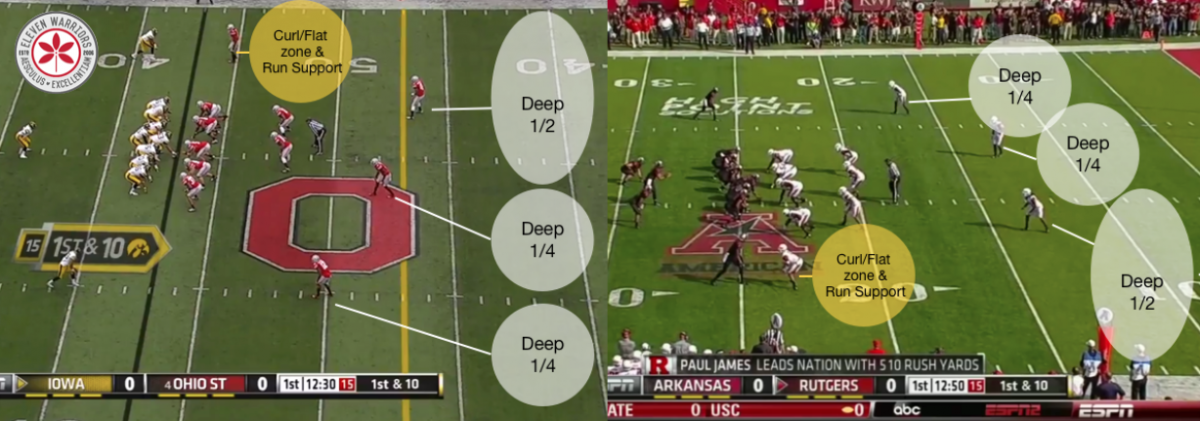
Knowing OSU is committing 8 men to the run on every play does allow the defense to be more exposed to the deep, play-action pass, however. For over a decade, the OSU defense has been predicated upon not allowing opposing offenses to hit the ‘home run’, and instead make opponents beat them by executing long drives of short yardage plays.
However, as Sammy Watkins and the Clemson offense showed, if you give an offense easy plays to execute (such as screens and short crossing routes), they will beat you if their athletes are superior to yours (and Sammy Watkins is a better athlete than anyone on OSU’s roster). So, prepare for an occasional deep ball over the head of an OSU safety as he is watching an opposing running back in the backfield. Just try to remember all the tackles that safety made in the box previous to that play, before you roast him on Twitter.
While this may sound fairly fundamental, Ohio State’s defense is in major need of core philosophies. 2013 saw the Buckeyes’ formations, schemes, personnel, and responsibilities shifting on a week-to-week basis. While that may have made it more difficult for opposing coaches to game-plan for the Buckeyes, opposing players had little trouble executing their core concepts, as those offenses had often practiced their schemes all season long, when the Buckeyes had only a week or two to practice theirs.
Much in the same way Urban Meyer and Tom Herman approach the offense – calling for the inside running game to drive everything else they do – I expect Ash’s biggest impact to be the emergence of a real identity for the Ohio State Defense as the 2014 season progresses.
